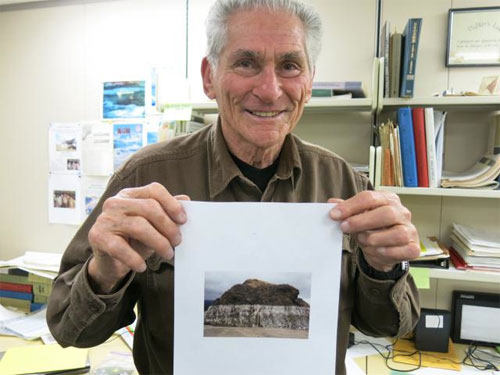
Feet on the ground right after Alaska's big oneBy NED ROZELL
January 09, 2014
“It was almost quitting time for the day at the meeting when some guys came back from the Space Needle and said they felt rocking,” Plafker said recently at his office in Menlo Park, California. “We said, ‘That’s a serious earthquake.’” It was, of course, the second-strongest earthquake in the era of instruments able to measure them, one that would change the direction of Plafker’s career and what people thought about great earthquakes on the Pacific basin’s Ring of Fire.
George Plafker, here in his Menlo Park, California, office, shows a photo he took in 1964 showing an uplifted Alaska shoreline marked by raised barnacles.
He flew to Alaska for a one-week trip after the earthquake. During that time he traveled much of Prince William Sound to inspect the torn, uplifted and sunken landscape. He talked to people who had seen terrible, incredible things. Realizing a once-in-a-lifetime opportunity, he and other scientists ended up returning to spend most of the summer of 1964 in Alaska. On the initial trip a few days after the earthquake, two of his colleagues focused on Anchorage and Alaska’s road system. Plafker caught military helicopter rides and flew in Bush planes to villages and unoccupied islands in Prince William Sound. He covered much of that country with Jim Osborne, a pilot for Cordova Airlines, who took Plafker to what was left of some villages on Osborne’s mail route. Plafker remembers flying to Chenega Bay, where 76 people lived before the earthquake. A wave caused by the earthquake drowned 25 of those people. “There was not one single livable house there,” said Plafker, who snapped a photo of a naked hillside with only one building - a schoolhouse - visible above a hillside of tree stubs. He interviewed a survivor who described a “wall of water 90 feet high.” Plafker saw with his own eyes that ocean water had entered the school building almost 100 feet above sea level. The earthquake-caused wave at Chenega Bay, which Plafker attributed to a small group of nearby islands focusing the onrushing water, was one example of the water displaced by the great earthquake. More than 100 people died in Alaska and others as far south as Oregon when tsunamis rushed down the west coast of the U.S. and Canada. “A movement similar to that of water in a tilted pan could have resulted from the sudden tectonic uplift of the western part of Prince William Sound and the contiguous continental shelf during the earthquake,” Plafker wrote with co-authors Arthur Grantz and Reuben Kachadoorian in the USGS publication based on their first Alaska trip. A few days after the earthquake, Plafker hoped to find clean marks of ripped earth that would point to the fault that caused the earthquake, but the most striking visual was of barnacles on oceanside rocks. Some were high as his belt buckle despite the fact that the creatures needed salt water to survive. “On that first go-round, we saw those things uplifted all over the place,” he said. On later trips, including when he spent most of the summer exploring from a converted tugboat, the barnacles became more obvious signs of ground uplifted by the earthquake. Besides the stink of decay, the high and dry barnacles, mussels and other marine life stood out like a whitewashed wall. “The whole of Prince William Sound looked like that,” he said, holding a photo that shows a pale band on shoreline rocks. “You could really see these critters knew exactly where they should be. If they got a little too high, they were dead.” Using the barnacles as one of many clues, Plafker made more than 800 measurements that summer of land shoved upward. In other places forests and shrubs had dropped, becoming flooded with salt water. Plafker and his colleagues calculated that an area about the size of Washington had been lifted toward the sky. On all his Alaska travels that summer, Plafker did not see what he was looking for — the clean line of damage from a fault like the San Andreas in California. That’s because Plafker and his colleagues were gathering evidence for what author Jerry Thompson described in Cascadia’s Fault as “the exciting idea that a slab of the Pacific Ocean floor might be sliding underneath the state of Alaska.” Plafker’s work helped prove the existence of the subduction zone that causes many earthquakes off the coast of Alaska and elsewhere on the Pacific’s Ring of Fire. He may be the only scientist to have walked the ground in Alaska in 1964, in Indonesia following the tsunami forty years later, and in Japan following the earthquake and tsunami in 2011. He still marvels that the great Alaska earthquake killed so few people 50 years ago. “It’s a miracle,” he said. “An earthquake of the exact same size killed 225,000 people in Sumatra.” This spring, Plafker will travel to Alaska for a field trip and to give talks as the 50th anniversary of the earthquake nears. In the meantime, he’s looking at a core of earth pulled from a slough near Cordova. In that muck, stored in a cold room at Menlo Park, is the evidence of nine giant earthquakes in the last 6,400 years. “We’re trying to predict how frequently these things happen,” he said. “The good news for people in Anchorage is it takes a long time to build up the strain to have a 1964-type earthquake.”
E-mail your news &
photos to editor@sitnews.us
|
||
